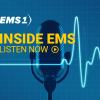Editor’s Note: Post a question in the comment section for Cebollero and Grayson to discuss in an upcoming podcast.
Download this week’s episode on iTunes, SoundCloud or via RSS feed
In this week’s Inside EMS Podcast, hosts Chris Cebollero and Kelly Grayson discuss a question from listener Wade Johnson, who asks if we are putting too many educational restraints on EMS volunteers.
“Not at all,” Grayson said.
But Cebollero questions what volunteers really have to know to respond.
“Do they have to be trained to the level of an EMT to be efficient to get people from point A to point B?” Cebollero asks.
Grayson said in terms of driving the ambulance, no, but “I reject vehemently the idea that there needs to be lesser educational standards for volunteer EMTs. It’s not a good way to go.”
Cebollero suggests there may be a need for a volunteer EMS certification that’s separate than an EMT certification. In rural areas especially, it’s better to have someone with some level of training respond as opposed to nobody.
“I would rather have somebody take me to the hospital, or take my spouse to the hospital, than her lay on the floor because nobody was available,” Cebollero said.
Grayson said volunteerism is at an all-time high in the U.S., and EMS is “looking for the wrong people.” The industry should reach out to retirees, stay-at-home mothers and people looking for a way to give back to the community.
“We need,” he said, “to start recruiting care takers rather than adrenaline junkies.”
They also banter about a recent EMS1 post on the top 20 tunes to play on the way to a call.
“I’m pretty much down with anything that has a beat,” Grayson said. “As long as it’s not thrash metal or gagster rap.”
In the News, they tackle reports of a new drug, “flakka” that’s been showing up in Florida. It’s cheap, potent and has been described as the next generation of synthetic drug that has been linked to a string of bizarre, sometimes violent incidents.
Cebollero describes it as a bath salt that also mimics ecstasy. It involves changing the molecular structure of the narcotic so that doesn’t change how it makes people feel, and be sold legally.
“I’ve got to tell you man, this designer drug thing is becoming a billion dollar business,” Cebollero said. “This is something we’ve really got to be concerned with.”
They also discuss a paramedic and EMS instructor who was found with 12 grams of meth and a couple grams of cocaine following a traffic stop, and new DHS ambulance safety resources that recommend physical design standard and operating procedures.












